Vyasa
Krishna Dvaipayana (Sanskrit: कृष्णद्वैपायन, romanized: Kṛṣṇadvaipāyana), better known as Vyasa (/ˈvjɑːsə/; Sanskrit: व्यासः, romanized: Vyāsaḥ, lit. 'compiler') or Vedavyasa (वेदव्यासः, Veda-vyāsaḥ, "the one who classified the Vedas"), is a central and revered sage portrayed in most Hindu traditions. He is traditionally regarded as the author of the Mahabharata. He is also regarded by many Hindus as the compiler of a number of significant scriptures. As a partial incarnation, Amsa Avatar (aṃśa-avatāra) of Vishnu, he is also regarded by tradition as the compiler of the mantras of the Vedas into four Vedas, as well as the author of the eighteen Puranas and the Brahma Sutras. He is one of the seven Chiranjeevis.
| Part of a series on |
| Vaishnavism |
|---|
 |
| Part of a series on |
| Dvaita |
|---|
 |
| Hinduism portal |
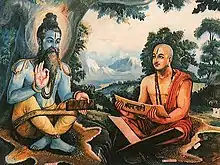
Vyasa | |
|---|---|
 Vyasa grants Sanjaya divine vision | |
| Personal | |
| Born | Krishna Dvaipayana |
| Religion | Hinduism |
| Spouse | Vatikā [1] |
| Children | Legitimate (from Vatikā)
|
| Parents |
|
| Known for | Mahabharata |
| Relatives | Maternal Half-Brothers (From Shantanu)
|
| Religious career | |
Disciples
| |
| Honours | Festival of Guru Purnima, also known as the Vyasa Purnima, is dedicated to him |
| Part of a series on | |
| Hindu philosophy | |
|---|---|
 | |
| Orthodox | |
|
|
|
| Heterodox | |
|
|
|
Name
Vyasa's birth name is Krishna Dvaipayana, which possibly refers to his dark complexion and birthplace,[2] although he is more commonly known as "Veda Vyasa" (Veda Vyāsa) as he has compiled the single, eternal Veda into four separate books — Rigveda, Samaveda, Yajurveda and Atharvaveda.[3][4]
The word "Vyasa" (Vyāsa) refers to "compiler," or, "arranger,"[5][6] and also means "separation," or, "division."[5] Other meanings are "split," "differentiate," or, "describe." It is also a title, given to "a holy sage or a pious learned man," and applied to "persons distinguished for their writings."[7]
Swami Vivekananda expresses the opinion that Vyasa may not have been a single person but a lineage of sages who were content to simply develop the ideas without claiming credit, as they were free from desire for the results their work, and hence attributed the authorship to Vyasa.[8] He says that Vyasa being only a title, anyone who composed a new Purana was known by the name Vyasa.[9]
Hindus traditionally hold that Vyasa categorized the primordial single Veda into four canonical collection. Hence he was called Veda Vyasa, or "Splitter of the Vedas," the splitting being a feat that allowed people to understand the divine knowledge of the Veda.
The Vishnu Purana elaborates on the role of Vyasa in Hindu chronology.[10] The Hindu view of the universe is that of a cyclic phenomenon that comes into existence and dissolves repeatedly. Each kalpa cycle is presided over by a number of Manus, one for each manvantara, and each manvantara has a number of Yuga Cycles, each with four yuga ages of declining virtues. The Dvapara Yuga is the third yuga. The Vishnu Purana (Book 3, Ch 3) says:
In every third world age (Dvapara), Vishnu, in the person of Vyasa, in order to promote the good of mankind, divides the Veda, which is properly but one, into many portions. Observing the limited perseverance, energy and application of mortals, he makes the Veda fourfold, to adapt it to their capacities; and the bodily form which he assumes, in order to effect that classification, is known by the name of Veda-Vyasa. Of the different Vyasas in the present Manvantara and the branches which they have taught, you shall have an account. Twenty-eight times have the Vedas been arranged by the great Rishis in the Vaivasvata Manvantara [...] and consequently, eight and twenty Vyasa's have passed away; by whom, in the respective periods, the Veda has been divided into four. The first... distribution was made by Svayambhu (Brahma) himself; in the second, the arranger of the Veda (Vyasa) was Prajapati [...] (and so on up to twenty-eight).[11]
According to the Vishnu Purana, Aswatthama, the son of Drona, will become the next sage (Vyasa) and will divide the Veda in 29th Maha Yuga of 7th Manvantara.[12]
Attributed texts
The Mahabharata
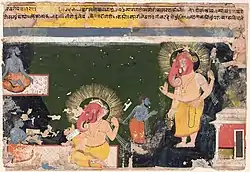
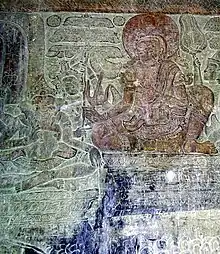
Vyasa is traditionally regarded as the chronicler of this epic and also features as an important character in Mahābhārata. It is believed that Vyasa asks Ganesha to assist him in writing the text. Ganesha imposes a precondition that he would do so only if Vyasa would narrate the story without a pause. Vyasa set a counter-condition that Ganesha understands the verses first before transcribing them. Thus Vyasa narrated the entire Mahābhārata.
Vyasa's Jaya (literally, "victory"), the core of the Mahabharata, is a dialogue between Dhritarashtra (the Kuru king and the father of the Kauravas, who opposed the Pāndavas in the Kurukshetra War) and Sanjaya, his adviser and charioteer. Sanjaya narrates the particulars of the Kurukshetra War, fought in eighteen days, chronologically. Dhritarashtra at times asks questions and expresses doubts, sometimes lamenting, fearing the destruction the war would bring on his family, friends and kin.
Large and elaborate lists are given, describing hundreds of kingdoms, tribes, provinces, cities, towns, villages, rivers, mountains, forests, etc. of the (ancient) Indian subcontinent (Bhārata Varsha). Additionally, he gives descriptions of the military formations adopted by each side on each day, the death of individual heroes and the details of the war-races. Eighteen chapters of Vyasa's Jaya constitute the Bhagavad Gita, a sacred text in Hinduism. The Jaya deals with diverse subjects, such as geography, history, warfare, religion and morality.
The 100,000 verses of Vyasa's work Mahābhārata is told by Vaishampayana to Janamejaya. It is structured as a narration by Ugrasrava surnamed Sauti, a professional storyteller, to an assembly of rishis who, in the forest of Naimisha, had just attended the 12-year sacrifice known as Saunaka, surnamed Kulapati. At 100,000 verses, the Mahābhārata is the longest epic poem ever written. The Bhagavad Gita is presented in Bhishma Parva.[13]
Other texts attributed
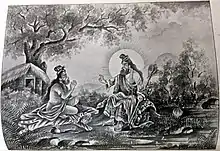
Puranas
Vyasa is also credited with the writing of the eighteen major Purāṇas,[4] which are works of Indian literature that cover an encyclopedic range of topics covering various scriptures. He narrated the Devi-Bhagavata Purana to Parikshit's son Janamejaya.
Brahma Sutras
The Brahma Sutras, one of the foundational texts of Vedanta, is written by Badarayana also known as Veda Vyasa.[14] Badarayana is also called Vyasa, which literally means "one who arranges".[14][15]
In the Mahabharata
Birth
During her youth, Satyavati was a fisherwoman who used to drive a boat. One day, she helped Parashara to cross the river Yamuna. He was enchanted by her beauty and wanted an heir from her. Initially, Satyavati did not agree, telling that if others would see them, then her purity would be questioned. Parashara created a secret place in bushes of a nearby island and a blanket of thick fog. She conceived and immediately gave birth to a son.[3] Parashara named him Krishna Dvaipayana, referring to his dark complexion and birthplace.[16] Dvaipayana became an adult and promised his mother that he would come to her when needed. Parashara restored Satyavati's virginity, gifted her an enchanting smell and left with his son. Satyavati kept this incident a secret, not telling even King Shantanu whom she was married to later.[3][17]
Niyoga and birth of Vichitravirya's sons

Shantanu and Satyavati had two sons, named Chitrāngada and Vichitravirya. Both of them died early without leaving an heir, but Vichitravirya had two wives - Ambika and Ambalika. A widowed Satyavati initially asked her stepson, Bhishma, to marry both the queens, but he refused, citing his vow of celibacy. Satyavati revealed her secret past and requested him to bring her firstborn to impregnate the widows under a tradition called Niyoga.[18] By this time, Vyasa had compiled the Vedas.
Sage Vyasa was unkempt because of months of meditation in the forest. Hence upon seeing him, Ambika who was rather scared shut her eyes, resulting in their child, Dhritarashtra, being born blind. The other queen, Ambalika, turned pale upon meeting Vyasa, which resulted in their child, Pandu, being born pale. Alarmed, Satyavati requested that Vyasa meet Ambika again and grant her another son. Ambika instead sent her maid to meet Vyasa. The duty-bound maid was calm and composed; she had a healthy child who was later named Vidura.
Connection with the Pandavas and Kauravas
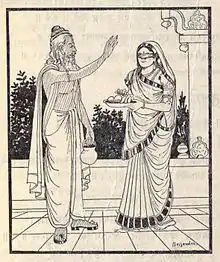
When the children of Vichitravirya grew up, Bhishma got them married to different women. Dhritarashtra was married to Gandhari, princess of Gandhara. Pandu married Kunti and Madri. Pandu left the kingdom, leaving Dhritarashtra as the acting king. Gandhari, during her adolescence, received a boon to have a hundred children but her pregnancy was taking a long period of time. After two years of pregnancy, Gandhari aborted her developing fetus, giving birth to a hard mass that looked like an iron ball. Vyasa came to the kingdom and using his knowledge, he asked to divide the mass into one hundred and one-pieces and put them into pots for incubation. After a year, 101 babies were born. Meanwhile, Pandu's wives, Kunti and Madri, were blessed with three and two sons, respectively.
While everybody rejoiced at the news of the birth of the Pandavas and Kauravas, misery took place in the forest. Pandu, who was cursed, died because of his attempt to make love with Madri. Kunti and the Pandavas returned to Hastinapura. Vyasa, feeling sorrow for his mother's fate, asked her to leave the kingdom and come with him to live a peaceful life. Satyavati, along with her two daughters-in-law, went to the forest.
Disciples
Vyasa had a son named Shuka, who was his spiritual successor and heir.[note 1] As per Skanda Purana, Vyasa married Vatikā, alias Pinjalā, who was the daughter of a sage named Jābāli. It is described that Vyasa's union with her produced his heir, who repeated everything that he heard, thus receiving the name Shuka (lit. Parrot).[1][19][20] Other texts including the Devi Bhagavata Purana also narrate the birth of Shuka but with drastic differences. Vyasa was desiring an heir, when an apsara (celestial damsel) named Ghritachi flew in front of him in form of a beautiful parrot, causing him sexual arousal. He discharges his semen, which fell on some sticks and a son developed. This time, he was named Shuka because of the role of the celestial parrot.[3] Shuka appears occasionally in the story as a spiritual guide to the young Kuru princes.
Besides his heir, Vyasa had four other disciples — Paila, Jaimini, Vaishampayana and Sumantu.[4] Each one of them was given the responsibility to spread one of the four Vedas. Paila was the made the incharge of Rigveda, Jaimini of the Samaveda, Vaishampayana of the Yajurveda and Sumantu of Atharvaveda.[21]
Vyasa is believed to have lived on the banks of Ganga in modern-day Uttarakhand. The site was also the ritual home of the sage Vashishta, along with the Pandavas, the five brothers of the Mahabharata.[22]
Vyasa is also mentioned in the Sankara Digvijaya. He confronts Adi Shankara, who has written a commentary on the Brahma-Sutras, in the form of an old Brahmana, and asks for an explanation of the first Sutra. This develops into a debate between Shankara and Vyasa which lasts for eight days. Recognizing the old Brahmana to be Vyasa, Shankara makes obeisance and sings a hymn in his praise. Thereupon, Vyasa inspects and approves Shankara's commentary on the Brahma-Sutras. Adi Shankara, who was supposed to die at the end of his sixteenth year, express his desire to leave his body in the presence of Vyasa. Vyasa dissuades him and blesses him that he may live for another sixteen years to complete his work.[23]
Also a town in India is named after him - Vyasanagar (a very famous town in Odisha).
Festival
The festival of Guru Purnima is dedicated to Vyasa. It is also known as Vyasa Purnima, the day believed to be both of his birth and when he divided the Vedas.[24][25]
The mythological Vyasa Sarovara is located at Vyasangar. It hosts an 11-day fair in celebration of Vyasa in the month of March.
In Sikhism
In Brahm Avtar, one of the compositions in Dasam Granth, Guru Gobind Singh mentions Rishi Vyas as an avatar of Brahma.[26] He is considered the fifth incarnation of Brahma. Guru Gobind Singh wrote a brief account of Rishi Vyas's compositions about great kings— Manu, Prithu, Bharath, Jujat, Ben, Mandata, Dilip, Raghu Raj and Aj[26][27]— and attributed to him the store of Vedic learning.[28]
See also
- Chiranjivi
- Parashara
- Guru Gita
- Gnana Saraswati Temple, Basar
- Vedic mythology
Notes
- Later, Vyasa became the surrogate father of Kuru princes — Pandu and Dhritrashtra
References
- Dalal 2019.
- Essays on the Mahābhārata, Arvind Sharma, Motilal Banarsidass Publisher, p. 205
- Mani, Vettam (1975). Puranic Encyclopaedia: A Comprehensive Dictionary With Special Reference to the Epic and Puranic Literature. Delhi: Motilal Banarsidass. pp. 885 (Vyāsa). ISBN 0-8426-0822-2.
- Sullivan, Bruce M. (1999). Seer of the Fifth Veda: Kr̥ṣṇa Dvaipāyana Vyāsa in the Mahābhārata. Motilal Banarsidass Publ. ISBN 978-81-208-1676-3.
- Sanskrit Dictionary for Spoken Sanskrit, Vyasa
- Gopal, Madan (1990). K.S. Gautam (ed.). India through the ages. Publication Division, Ministry of Information and Broadcasting, Government of India. p. 158.
- Gopal, Madan (1990). K.S. Gautam (ed.). India through the ages. Publication Division, Ministry of Information and Broadcasting, Government of India. p. 129.
- Vivekananda, Swami (2016). "The work before us". The complete works of Swami Vivekananda. Advaita Ashrama. ISBN 978-81-7505-392-2. OCLC 1126811997.
- Vivekananda, Swami (2016). "Thoughts on Gita". The complete works of Swami Vivekananda. Advaita Ashrama. ISBN 978-81-7505-392-2. OCLC 1126811997.
- Encyclopaedic Dictionary of Puranas, Volume 1 (2001), page 1408
- "Vishnu Purana". Retrieved 15 March 2014.
- Vishnu Purana -Drauni or Asvathama as Next Vyasa Retrieved 2015-03-22
- "Mahabharata". World History Encyclopedia. Retrieved 1 April 2022.
- Radhakrishna, Sarvepalli (1960). Brahma Sutra, The Philosophy of Spiritual Life. p. 22 with footnote 3 and 4.
- The Yoga Sutras of Patanjali. Edwin F. Bryant 2009 page xl
- Monier-Williams, Sir Monier (1875). Indian Wisdom, Or, Examples of the Religious, Philosophical, and Ethical Doctrines of the Hindūs: With a Brief History of the Chief Departments of Sanskṛit Literature, and Some Account of the Past and Present Condition of India, Moral and Intellectual. Wm. H. Allen & Company.
- Dalal, Roshen (18 April 2014). Hinduism: An Alphabetical Guide. ISBN 9788184752779.
- Bhawalkar, Vanamala (2002). Eminent women in the Mahābhārata. Sharada. ISBN 9788185616803.
- Pattanaik 2000.
- Skanda Purāṇa, Nāgara Khanda, ch. 147
- Shastri, J. L.; Tagare, Ganesh Vasudeo (1 January 2004). Ancient Indian Tradition and Mythology Volume 7: The Bhagavata-Purana Part 1. Motilal Banarsidass. ISBN 978-81-208-3874-1.
- Strauss, Sarah (2002). "The Master's Narrative: Swami Sivananda and the Transnational Production of Yoga". Journal of Folklore Research. Indiana University Press. 23 (2/3): 221. JSTOR 3814692.
- Vidyaranya, Madhava. Sankara Digvijaya The Traditional life of Sri Sankaracharya. Canto 7: Sri Ramakrishna Math Chennai. p. 70. ISBN 8178233428.
{{cite book}}: CS1 maint: location (link) - Awakening Indians to India. Chinmaya Mission. 2008. p. 167. ISBN 978-81-7597-434-0.
- What Is Hinduism?: Modern Adventures Into a Profound Global Faith. Himalayan Academy Publications. 2007. p. 230. ISBN 978-1-934145-00-5.
- Dasam Granth, Dr. SS Kapoor
- Line 8, Brahma Avtar, Dasam Granth
- Line 107, Vyas Avtar, Dasam Granth
Sources
- Dalal, Roshen (6 January 2019). The 108 Upanishads: An Introduction. Penguin Random House India Private Limited. ISBN 978-93-5305-377-2.
- Maas, Philipp A. (2006), Samādhipāda. Das erste Kapitel des Pātañjalayogaśāstra zum ersten Mal kritisch ediert. (Samādhipāda. The First Chapter of the Pātañjalayogaśās-tra for the First Time Critically Edited)., Aachen: Shaker
- Pattanaik, Devdutt (1 September 2000). The Goddess in India: The Five Faces of the Eternal Feminine. Simon and Schuster. ISBN 978-1-59477-537-6.
Further reading
- The Mahabharata of Krishna-Dwaipayana Vyasa, translated by Kisari Mohan Ganguli, published between 1883 and 1896
- The Arthashastra, translated by Shamasastry, 1915
- The Vishnu-Purana, translated by H. H. Wilson, 1840
- The Bhagavata-Purana, translated by A. C. Bhaktivedanta Swami Prabhupada, 1988 copyright Bhaktivedanta Book Trust
- The Jataka or Stories of the Buddha's Former Births, edited by E. B. Cowell, 1895
External links
 Quotations related to Vyasa at Wikiquote
Quotations related to Vyasa at Wikiquote Media related to Vyasa at Wikimedia Commons
Media related to Vyasa at Wikimedia Commons Works by or about Vyasa at Wikisource
Works by or about Vyasa at Wikisource- The Mahābhārata – Ganguli translation, full text at sacred-texts.com

